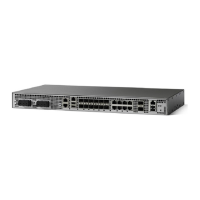23
Cisco IOS XE 3S Release Notes for the Cisco ASR 903 Router
OL-26630-12
Chapter
Caveats in Cisco IOS XE 3.8S Releases
Resolved Caveats—Cisco IOS XE Release 3.8(1)S
This section documents the issues that have been resolved in Cisco IOS XE Release 3.8(1)S.
• CSCty30951
Symptom: The router displays the following console error message:
%QOSMGR-3-OUT_OF_TCAM_RESOURCES: SIP0: nile_mgr: Out of tcam resources to execute
command
Conditions: Occurs when you remove a QoS configuration by setting the interface to the default
configuration.
Workaround: There is no workaround.
• CSCty70119
Symptoms: Port shaper rate changes do not take effect.
Conditions: Occurs when QoS policies attached to EVCs on an interface do not include a shaper
configuration; the issue does not occur on EFP policies that include a shaper in a class.
Workaround: Include a shaper in one class of the EFP policy.
• CSCtz03919
Symptoms: The router fails to store trace logs.
Conditions: Occurs when the /bootflash directory is full.
Workaround: Clean up the /bootflash and then reboot the router.
• CSCtz20839
Symptoms: IMA functionality does not work properly.
Conditions: Occurs after an RSP switchover when the router is running an IMA configuration.
Workaround: Reload the interface module with the IMA configuration.
• CSCua62029
Symptom: The router crashes.
Conditions: Occurs when you configure a class-based QoS policy with the following
characteristics:
–
The policy is attached to the main interface.
–
The policy classifies on multiple VLANs.
–
The classification statements specify a priority.
–
The classification statements are within a child QoS policy.
Workaround: There is no workaround.
• CSCua73104
Symptoms: The router does not increment QoS port shaper policy counters displayed by the show
policy interface command.
Conditions: Occurs when you configure
–
A class-default policy on a physical interface
–
A class-based policy on an EVC interface
Workaround: There is no workaround; however, the router applies the QoS policy normally.

